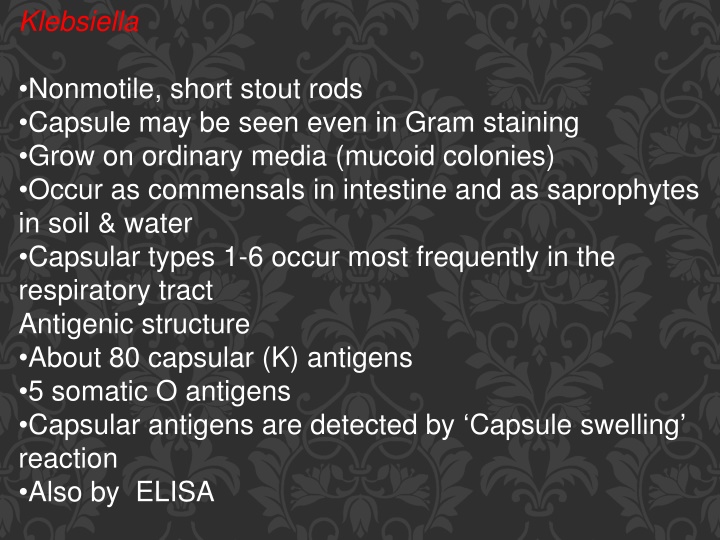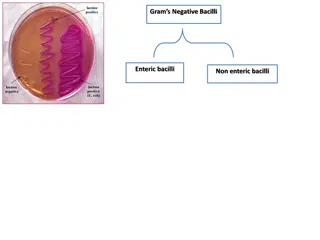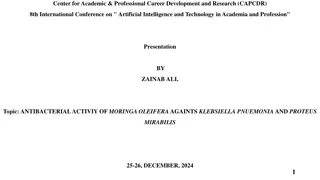
Klebsiella Infections and Treatment Options
Learn about Klebsiella, its pathogenic species, diseases it causes, virulence factors, diagnosis tests, and treatment options. Klebsiella is a nonmotile, short stout rod bacteria that can lead to pneumonia, UTI, and other serious infections, posing a challenge due to antibiotic resistance.
Download Presentation

Please find below an Image/Link to download the presentation.
The content on the website is provided AS IS for your information and personal use only. It may not be sold, licensed, or shared on other websites without obtaining consent from the author. If you encounter any issues during the download, it is possible that the publisher has removed the file from their server.
You are allowed to download the files provided on this website for personal or commercial use, subject to the condition that they are used lawfully. All files are the property of their respective owners.
The content on the website is provided AS IS for your information and personal use only. It may not be sold, licensed, or shared on other websites without obtaining consent from the author.
E N D
Presentation Transcript
Klebsiella Nonmotile, short stout rods Capsule may be seen even in Gram staining Grow on ordinary media (mucoid colonies) Occur as commensals in intestine and as saprophytes in soil & water Capsular types 1-6 occur most frequently in the respiratory tract Antigenic structure About 80 capsular (K) antigens 5 somatic O antigens Capsular antigens are detected by Capsule swelling reaction Also by ELISA
Gram- Negative Cell Wall
Pathogenic species Klebsiella pneumoniae Klebsiella ozaenae Klebsiella rhinoscleromatis Klebsiella pneumoniae (Friedlander s bacillus) Second most common member of aerobic bacterial flora of human intestine Causes pneumonia, UTI, pyogenic infections (abscess, meningitis etc.), septicaemia and rarely diarrhoea Important cause of nosocomial infections
Pneumonia: in middle aged & older persons with predisposing factors bronchopulmonary diseases, alcoholism. Massive mucoid inflammatory exudate with necrosis and abscess formation. Blood culture positive in 25% cases. Klebsiella ozaenae - Cause ozena (disease with foul smelling nasal discharge) Klebsiella rhinoscleromatis Cause rhinoscleroma ( granulomatous hypertrophy of nose) . Virulence factors: Capsule Adhesions Iron capturing ability
UTI:Strains resistant to antibiotics Diarrhoea: Strains produce plasmid mediated enterotoxin (similar to E. coli). Laboratory Diagnosis tests: Specimens:sputum,urine,pus,blood. Staining :G- baclli. Capsule test:swelling reaction test(Quellung reaction) Culture:specimens are plated on blood agar,MaCconkey agar(pinkish ,mucoid colonies). Biochemical tests: GLSM: + + + + IMViC: - - + + Urease positive Treatment Cephalosporin,trimethoprime- sulfamethaxazole,aminoglycosides,pepiracillin.









